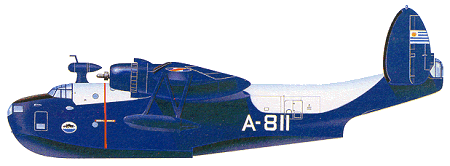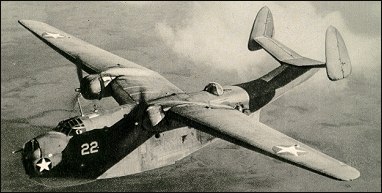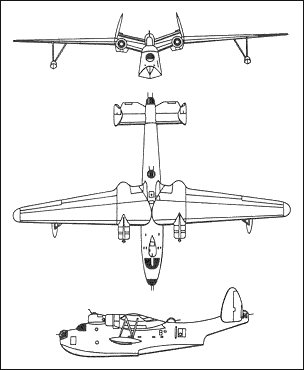|
| The XPBM-1 prototype flying-boat patrol bomber was originally ordered by the US Navy in 1936. Before it was built, a quarter-size prototype (Model 162A) was constructed and flown. The full-size aircraft was flown for the first time in February 1939.
The production PBM-1 - fitted with two 1,192 kW Wright R-2600-6 radial engines, a dihedral tail and retractable wingtip floats - was ordered in 1938 and 20 of these went into Navy service in 1941. A single XPBM-2 was ordered at the same time as a long-range version specially strengthened for catapult take-off.
The PBM-3, with two 1,267kW Wright R-2600-12 engines, was ordered in quantity in 1940 and deliveries began in 1942. In this version the crew was increased from seven to nine, the armament was revised and the fuel capacity increased. The retractable wingtip floats of the PBM-1 were replaced by fixed floats. In 1942 the PBM-3 was adopted also as a naval transport carrying 20 passengers or 3,629-4,082kg of cargo (PBM-3R). Twenty-six PBM-3B patrol bombers were also used by RAF Coastal Command, delivered under Lend-Lease. At the end of the war a specialised anti-submarine version was also developed as the PBM-3S.
The final two production versions of the Mariner were the PBM-5 and PBM-5A, powered by 1,565kW R-2800-22 and R-2800-34 engines respectively. The last PBM-5A was delivered to the US Navy in April 1949. This version was basically an amphibious version of the PBM-5 and ended its career as a general utility aircraft.

| CREW | 7 |
| ENGINE | 2 x Wright A-5B, 1250kW |
| WEIGHTS |
| Take-off weight | 25400 kg | 55998 lb |
| Empty weight | 14660 kg | 32320 lb |
| DIMENSIONS |
| Wingspan | 36.0 m | 118 ft 1 in |
| Length | 34.4 m | 113 ft 10 in |
| Height | 8.4 m | 28 ft 7 in |
| Wing area | 130.0 m2 | 1399.31 sq ft |
| PERFORMANCE |
| Max. speed | 325 km/h | 202 mph |
| Cruise speed | 240 km/h | 149 mph |
| Ceiling | 6150 m | 20200 ft |
| ARMAMENT | 8 x 12.7mm machine-guns, 2000kg of bombs |
| Justin Settle, e-mail, 05.08.2012 03:47 My Grandad is Charlie Settle, tail gunner on a PBM in VPB-28. Served in the Phillipines in 44, 45. Black Cat Squadrons. Please contact me if you remember him- it would make his year! reply | | Ken Simmons, e-mail, 22.05.2012 04:36 My uncle Earl Simmons was a aircrew radionman on PBM's I think he was with a training squadron at Corpus Christi during 1944-45. Then the war end, and he got discharge at Alameda. Trying to get an idea of what PBM's ATU commands where at Corpus during that time period reply | | Larry Lynch, e-mail, 14.05.2012 16:04 My elder brother served as an air-crewman on PBM-5 aircraft attached to VP 47 out of Alameda /Iwakuni. His plane crashed into the sea off the east coast of Korea on Dec 26, 1952. He and nine others were lost and four were rescued. The Navy Dept. never gave our family any details of the crash nor were any remains of my brother ever found. His name was Frederick Charles Lynch and he was from Fowler, California. I would really appreciate any info anyone may have of the incident, or who may have known him. Thanks in advance. reply | | Howard Eberly, e-mail, 17.04.2012 01:27 I was on Guam in VR-23, when we received 3 PBM-5As to be used as transports for the Trust Territories. We had to take off the gun turrets, armor plate, etc. to make them suitable for our mission. We later flew one of them out of Itazuki, Japan to Inchon Harbor where the Korean invasion was taking place. We took McArthurs envoy up to confer with the Commander of the invasion forces. Very interesting trips. The last existing 5A is at the air force museum at Davis Monthan AFB in Tucson. I had been trained to be a fighter pilot, but the Navy, in their infinate wisdom put me in transports. Probably saved my life. The 5A was sort of a strange looking piece of iron, but very comfortable and easy to fly. reply | |
| | Harry Derr, e-mail, 17.03.2012 06:25 mail back to me reply | | Harry Derr, e-mail, 17.03.2012 06:25 mail back to me reply | | Jack Sandberg, e-mail, 31.01.2012 23:55 I was with VPB 25 and flew all over the Pacific running missions looking for the last of the Japanese. Saw a lot bring brought in by the Marines. They were scared to death. Ended the war going to Okinowa but were run out by the Japanese Kamakazis and Baca bombs, (Suicides)ended the war stationed in Lingguyan Gulf where we flew missions in the China sea looking for who might be left. Not many got away. My rate was aom3 /c and was the bow gunner for almost years counting the training and over seas. Anybody remember VPB 25? reply | | Chuck Lockhart, e-mail, 30.01.2012 02:21 I Served with VP-892 and VP-50 from 1951 thru 1954 as a radioman on the PBM. It was a great experience and I cherish the Crew that I flew with. Not many of us are left. Would like to hear from any who remember. reply | | Jim Hommel, e-mail, 14.12.2011 09:54 Nothing romantic. Rode the base PBM on "milk runs" from NAS Agana to Saipan and Tinian a few times when off duty. 1952 - 1953. ACAN in base ops flight plannin. reply | | Don Swartz, e-mail, 15.11.2011 01:23 I was In VPB 28 in the Philippine Island Palawan and Jinamoc Any one around from then? reply | | Bill Graves, e-mail, 09.11.2011 19:58 My father flew PMs in the Pacific late in the war. His plane and one other spotted the Yamoto BB and several other ships in the task force. They then radioed for an air strike which lead to the Yamoto's sinking. The other PBM landed after the battle and picked up an American airman who had been shot down. My father's plane flew cover from overhead. I've still got his log book with the entries in it. His PBM was shot down on another mission while looking for Japaneese shipping west of Nagasaki. All survived and were picked up by another PBM the next day . JATO assist was needed to get the plane airborne due to heavy swells. reply | | Tom Munday, e-mail, 20.10.2011 01:13 Stationed at NOB, Trinidad,BWI, 1952-1954. Served as Air-crewman with VP-34. Last operating squadron of PBM's in Atlantic fleet.
Lost EC-10 March 22, 1953 with crew of 11, in Bermuda Triangle during Operation Springboard.
Primarily trained for ASW, provided search & rescue missions. Kept the Caribbean safe during Korean War. reply | | adcs patrick mc closkey, e-mail, 06.10.2011 23:46 I SPENT THE YEAR OF 1951-1952 ON NAVAL STATION KWAJALEIN IN THE MARSHALL ISLANDS WE HAD THREE PBM5A'S AT ONE TIME .IT WAS A GREAT ADVENTURE OURS WERE DEMILITARIZED SO WE HAD NO TURRETS .FLYING IN THE NOSE PROVIDED AN AWESOME VIEW WE HAD THE ONLY SEAPLANES IN THE WHOLE MID-PACIFIC SO SOME OF OUR MISSIONS WERE FABULOUS 15 HOUR PATROLS WERE COMMON .ONE OF THE GREATEST TIMES IN MY NAVAL AIR CAREER reply | | Don Swartz, e-mail, 05.10.2011 17:59 I was in VPb 28 in the Philippines at Cavite Flew patrols in !945. Anyone around from that Squadron? I was in Lt. Lucks crew. Our plane crew captain was Chief Whitby very well known Chief.an old salt If you were in "Whits" crew you had many privalages. reply | |
| | Harry L. Derr, e-mail, 28.09.2011 06:20 I served at tail-end of WWII from Sept.1945 through Dec.1948. We were in PBM-5A's but much later we were assigned to newer Martin air craft.
I was assigned to VP-208 at NAS,Jax,Fla. and went with the squadron from there to Gytmo.Bay, Cuba to San Juan to Port of Spain, Trinidad. I was a 3rd class AMMF, expert gunner, etc. and put in over a thousand hours chasing German sub reports, Air sea Rescue,weather watches, watching Castro and his boys as well as several other potential revolutioniaries in the Carribean. We had several changes is squadron name or designation: VPB-208, VPMS-8 and others. reply | | Donald Swartz, e-mail, 25.09.2011 18:56 Flew many patrols only one exciting mishap lost the starboard engine on take off.Landed safely. Not like D10 at Banana River where they lost engine and crashed several fatalities. reply | | Donald Swartz, e-mail, 25.09.2011 18:48 I was at Banana River March 1945 Lt Luck was our pilot Are copilots were Ens Wages and Ens Armstrong. Our crew ended up in the Philippines mostly out of Cavite And Jinamoc. We did mostly patrols and search and rescue missions. Any one around from VPB 28. Send me an email. reply | | Sam, e-mail, 16.09.2011 18:39 Help,
I am trying to track down specifics on a propeller that I believe may have been used on PBM-1 or early PBM-3's. The Prop. I am trying to determine the engine and aircraft it was used on is:
Three Bladed Curtiss Electric
DWG NO 89304-12
MFG - NO - B - 9155
CONT NO 61777
Hub is stamped: C - 17 - A ("A" I think)
Any information you can provide would be greatly appreciated.
Sincerly,
Sam
t6sam@rcn.com reply | | Bill DeArmond, e-mail, 21.08.2011 19:14 FYI-A group of Brazilians headed by Vilfredo and Heloisa Schurmann have found the wreckage of U-513 that was sunk on 19 July 1943 by a PBM of VP-74 piloted by Roy Whitcomb. reply | | Charles R Schilder, e-mail, 08.07.2011 21:39 I served with VP-42 from 1950 to 1952, based in Iwakuni, Japan and San Diego. Got shot up by three Chinese Migs off the China coast during a routine patrol watching ships go into North Korea. Would like to hear from any old squadron mates. reply |
|
Do you have any comments?
|
| 
COMPANY
PROFILE
All the World's Rotorcraft
|








